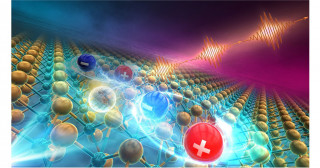Kyoto, Japan -- Glittering solar- roofs atop residential, commercial, and industrial buildings may soon get a new look with the carbon-based organic solar cell or OSC. Thinness and flexibility partly explain why OSCs may be a better alternative to traditional silicon-based cells.
But not all OSCs are created equal. Those based on nonfullerene -acceptors, or NFAs, have now been found to generate electricity efficiently even with a relatively low offset of 0.1 eV. Compared to conventional fullerene-based types, NFA-based OSCs achieve significantly higher power conversion efficiency.
"We then asked ourselves how this was achieved, and what materials we would need to develop in order to obtain the low offset," says KyotoU's Yasunari Tamai, whose team made the discovery.
Traditionally, a combination of so-called p-type polymers with n-type fullerene derivatives have been the preferred semiconductors used in OSCs, also called organic photovoltaics, or OPVs. A difference in the energy levels, or offset, of more than 0.3 eV is generally considered necessary to drive photovoltaic conversion. These conventional polymers can provide up to 10-11% of power conversion efficiency.
Tamai adds, "On the other hand, a large offset also drags down the open-circuit voltage. Efficient power conversion requires a trade-off between electric current and voltage in the form of a low offset."
The best solutions can sometimes be found by thinking outside the box, or in this case, reversing the thinking: lose the fullerene.
Recently, NFA-based OSCs have been found to generate efficient free carriers even with an offset of a mere 0.1 eV, topping regular fullerene-based OSCs by an impressive ten percent or more.
The team used transient absorption spectroscopy to track free carrier generation over time. As when a slalom skier glides down the hill from gate to gate, relaxed charges transfer freely down the energy cascade created in the solar cells.
"We hope that our research will help move the world closer to this practical application of organic solar cell technology to harness the virtually non-depletable energy source from our sun," concludes Tamai.

【DOI】https://doi.org/10.1039/d1ee03565g
【KURENAI ACCESS URL】http://hdl.handle.net/2433/269282
Shin-ichiro Natsuda, Toshiharu Saito, Rei Shirouchi, Yuji Sakamoto, Taiki Takeyama, Yasunari Tamai, Hideo Ohkita (2022). Cascaded energy landscape as a key driver for slow yet efficient charge separation with small energy offset in organic solar cells. Energy & Environmental Science, 15(4), 1545-1555.





